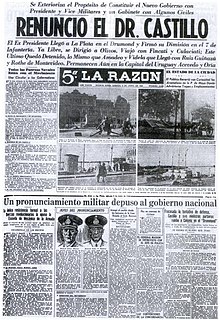 W
WThe 1943 Argentine coup d'état, also known as the Revolution of '43, was a coup d'état on 4 June 1943 that ended the government of Ramón Castillo, who had been fraudulently elected to the office of vice-president before succeeding to the presidency in 1942 as part of the period known as the Infamous Decade. The military was opposed to Governor Robustiano Patrón Costas, Castillo's hand-picked successor, a major landowner in Salta Province and a primary stockholder in the sugar industry. The only serious resistance to the military coup came from the Argentine Navy, which confronted the advancing army columns at the Navy Petty-Officers School of Mechanics.
 W
WThe 1944 San Juan earthquake took place in the province of San Juan, in the center-west area of Argentina, a region highly prone to seismic events. This moderate to strong earthquake destroyed a large part of San Juan, the provincial capital, and killed 10,000 of its inhabitants, 10% of its population at the time. One third of the province population became homeless. It is acknowledged as the worst natural disaster in Argentine history.
 W
WDescamisado is a Spanish word that literally means "without shirt" or "shirtless".
 W
WThe Eva Perón Foundation was a charitable foundation begun by Eva Perón, a prominent Argentine political leader, when she was the First Lady and Spiritual Leader of the Nation of Argentina. It operated from 1948 to 1955.
 W
WThe 1st Russian National Army was a pro-Axis army under Boris Smyslovsky, a Russian nobleman and former Tsarist guard officer, during World War II.
 W
WThe Labour Party was a populist political party in Argentina.
 W
WLoyalty Day is a commemoration day in Argentina. It remembers October 17, 1945, when a massive labour demonstration at Plaza de Mayo demanded the liberation of Juan Domingo Perón, who was jailed in Martín García island. It is considered the foundation day of Peronism.
 W
WThe Bombing of Plaza de Mayo was a massacre which took place in Buenos Aires, Argentina, on 16 June 1955. On that day, 30 aircraft from the Argentine Navy and Air Force strafed and bombed Plaza de Mayo square in Buenos Aires, in what remains to this day the largest aerial bombing ever on the Argentine mainland. The attack targeted the adjacent Casa Rosada, the official seat of government, as a large crowd was expressing support for president Juan Perón. The strike took place during a day of official public demonstrations to condemn the burning of a national flag allegedly carried out by detractors of Perón during the recent procession of Corpus Christi. The action was to be the first step in an eventually aborted coup d'état. The number of identified bodies was put at 308, including six children; an unknown number of victims could not be identified.
 W
WIn 1948, during President Juan Perón's first term of office, the seven British- and three French-owned railway companies then operating in Argentina, were purchased by the state. These companies, together with those that were already state-owned, where grouped, according to their track gauge and locality, into a total of six state-owned companies which later became divisions of the state-owned holding company Ferrocarriles Argentinos.
 W
WThe United Officers' Group or GOU was a nationalist secret society within the Argentine Army which staged a coup d'état in 1943 to overthrow President Ramón Castillo, thus ending the Infamous Decade and forming a military junta which lasted until 1945. Arturo Rawson was made President, but was only in office for a few days before the GOU replaced him with Pedro Pablo Ramírez.
 W
WThe history of Argentina during World War II is a complex period of time beginning in 1939, following the outbreak of war in Europe, and ending in 1945 with the surrender of Japan. German and Italian influence in Argentina was strong mainly due to the presence of numerous immigrants from both countries, and Argentina's traditional rivalry with Great Britain furthered the belief that the Argentine government was sympathetic to the German cause. Because of the close ties between Germany and Argentina, the latter stayed neutral for most of World War II, despite internal disputes and pressure from the United States to join the Allies. However, Argentina eventually gave in to the Allies' pressure, broke relations with the Axis powers on January 26, 1944, and declared war on March 27, 1945.